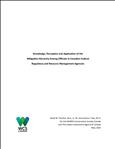Title
Knowledge, Perception and Application of the Mitigation Hierarchy Among Officials in Canadian Federal Regulatory and Resource Management Agencies
Author(s)
David W. Poulton; Justina C. Ray
Published
2023
Abstract
In the face of a steep decline in biodiversity there is an urgent need to develop new policy tools and improve the application of existing tools, including the assessment and mitigation of environmental impacts at the project level. As impact assessment has evolved as a profession and discipline impact assessment has developed frameworks and doctrines. Among those frameworks is the mitigation hierarchy. This prescribes that that one should avoid impacts first and foremost, then minimize those impacts not avoidable, then restore onsite where possible, and finally rely on offsetting or environmental compensation only as a last resort. It is a dictate that is found in policies, academic literature and professional guidance around the world, and in Canada. The rationale of the mitigation hierarchy is that intact functional ecosystems, those left undisturbed by avoidance and minimization measures, are more mature, complex and resilient than those created or restored by artificial means, the kind which form the basis for onsite restoration and offsetting. The practical challenges of offsetting in particular are well-documented. Despite the widespread acceptance of the mitigation hierarchy, three previous case studies examining the United States, Australia and the Province of Alberta have noted a tendency on the part of both regulators and proponents to move too quickly to offsetting as the preferred form of mitigation, thereby contradicting the hierarchy by effectively skipping several key stages. Some have suggested that this disregard of the hierarchy in practice is widespread. This may forego opportunities to optimize environmental outcomes by overlooking avoidance and minimization options. The purpose of this study was to examine whether that suspicion that the mitigation hierarchy is often disregarded was valid with respect to Canadian federal regulatory and resource management agencies. The qualitative method used to do this combined a review of legislation and policies, and of impact assessment processes, with 36 interviews with officials in eight different federal agencies and stakeholders with experience in dealing with those agencies. This was intended to explore experiences, perceptions and ideas among the interview participants. Our findings were: 1) While some familiarity with the mitigation hierarchy is widespread, there is no common framework or vocabulary across the federal family for considering mitigation options. 2) Knowledge of the mitigation hierarchy is not evenly distributed among participants from the examined federal agencies. Those participants in agencies with a focus on process management appear to have less working familiarity with the hierarchy than those in agencies having a more focused conservation mandate. 3) While many of the participants recognized the risk that offsetting could be used inappropriately to displace avoidance and minimization measures, this was viewed as uncommon in practice. Rather the more common view among participants was that the cost and practical difficulties of offsetting provide an incentive to avoid and minimize as much as possible to eliminate the need to consider offsetting. Some suggested that it was the very lack of clear policy direction and tools to enable offsetting that made it so difficult and reinforced this deterrent to offsetting. If this is so, those charged with developing offset policy and tools should be careful not to inadvertently enable offsetting as preferred mitigation. 4) We found no consensus among participants with respect to who is responsible for application of the mitigation hierarchy. 5) Many participants felt that the active consideration of the mitigation hierarchy may come too late in the IA process to encourage the use of certain mitigation options. In particular, there may not be enough opportunity to engage on early options for avoidance and minimization. As well, leaving the development of offsetting and other mitigation plans to the post-permitting stage shifts regulatory responsibility in a manner that may make effective mitigation more challenging. 6) Policy guidance and standards of practice published prior to and outside of any particular development application are effective aids to mitigation. They provide useful guidance to both proponents and regulators as to what kinds of activities are considered acceptable. Based on the above we conclude that the implementation of the mitigation hierarchy in Canada’s federal impact assessment process appears to be better than that previously studied in other jurisdictions. However, this appears to be less a result of a common understanding and dedication to the principles of the hierarchy than to the influence of situational economic incentives that deter proponents from pursuing offsetting. Based on that perception of our situation we make five recommendations to improve the application of the hierarchy in the federal regulatory realm: a) Develop a government-wide policy on the mitigation hierarchy and promote a shared vocabulary and setoff principles and practices. b) In each federal review process there should be a clear assignment of responsibility to oversee the use of the mitigation hierarchy. c) Consider the mitigation hierarchy at all stages of impact assessment, especially in the early planning stages. d) Minimize the use of post-permitting conditions, when the proponent has little incentive to be
ambitious. e) Prior guidance on best practices and acceptable site selection is extremely useful.
Full Citation
Poulton, D.W. and J.C. Ray (2023). Knowledge, Perception and Application of the Mitigation Hierarchy Among Officials in Canadian Federal Regulatory and Resource Management Agencies. Report for the Wildlife Conservation Society, Canada and The Impact Assessment Agency of Canada.
Access Full Text

Back
DMX4991900000